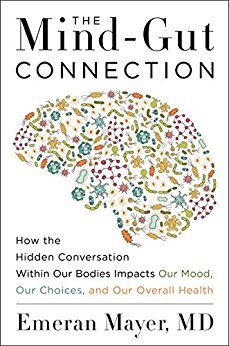More on this book
Community
Kindle Notes & Highlights
by
Emeran Mayer
Read between
March 13 - April 16, 2017
However, the full development of emotions and gut reactions requires an extensive lifelong learning process by which we train and fine...
This highlight has been truncated due to consecutive passage length restrictions.
There are some 8 million microbial genes in the gut—400 times more than in the human genome.
only 5 percent of them are shared between any two individuals.
gut microbiome adds a whole new dimension of complexity and possibilities to our brain-gut emotion-generating machinery.
I
strongly feel that it is the engagement of the gut, and its microbiome, that plays a major role in determining the intensity, duration, and uniqueness of our emotional feelings.
Thinking, Fast and Slow, psychologist Daniel Kahneman, co-winner of the 2002 Nobel Prize for economics, suggests that intuitive decision making is the “secret author of many of the choices and judgments [we] . . . make.” The idea that you can make decisions about what is best for you based on intuition or gut feelings—as opposed to donning a rational thinking cap—is central to the human condition.
Gut feelings reflect an extensive and often deeply personal body of wisdom that we have access
to, and that we trust more than the advice provided by family members, highly paid advisors, and self-declared experts or social media.
what is a gut ...
This highlight has been truncated due to consecutive passage length restrictions.
when does a gut sensation become an emotional feeling?
Bud Craig, a neuroanatomist who has advanced our understanding of the circuitry that allows your brain to listen to your body and vice versa.
recent book,
have played an important role in my own research, which looks at how your brain listens to your gut an...
This highlight has been truncated due to consecutive passage length restrictions.
In a theory based on neuroscientist Bud Craig’s paradigm-shifting concepts and a wealth of scientific data, different regions of this hidden island in our brain are thought to play specific roles in
recording, processing, evaluating, and responding
interoceptive inf...
This highlight has been truncated due to consecutive passage length restrictions.
The insular image is then refined, edited, and colored, similar to the process an actor’s or actress’s head shot undergoes after a film shoot.
the brain uses affective, cognitive, and attentional tools as well as
memory databases of previous experiences to refine the quality and salience of the image.
As the editing progresses, the brain’s attentional networks become more engaged, causing us to become more aware of the image and asso...
This highlight has been truncated due to consecutive passage length restrictions.
It is where your visceral sensations and gustatory experiences are sent to in your brain, allowing you to feel the need to eat or eliminate, re...
This highlight has been truncated due to consecutive passage length restrictions.
Once this process reaches the frontal part of the insular cortex, the image has all the features of a conscious emotional feeling that describes the state of your whole body ...
This highlight has been truncated due to consecutive passage length restrictions.
feeling well, feeling nauseated, feeling thirsty, hungry, or satiated, feeling relaxed,...
This highlight has been truncated due to consecutive passage length restrictions.
But what does our brain do with the myriad gut feelings we have accumulated over a lifetime?
The current scientific thinking is that this information is stored in an exponentially growing database,
The cycling experience in infancy of feeling full or hungry—good or bad—may lay the foundation for the moral judgments of good and bad that emerge into gut feelings later in life.
your gut registered how well your needs were met or not met in infancy.
A hungry baby left in its crib to cry for an hour perceives the world very differently from the baby who is quic...
This highlight has been truncated due to consecutive passage length restrictions.
How do the vast assemblies of gut microbes contribute to these early feelings of “good” and “bad”?
It’s plausible from animal studies that gut microbes influence the emotional state and development of infants the world over, from crying to cooing.
Some of it has to do with mother’s milk,
The gut microbes in all infants are adapted to optimally metabolize the complex carb...
This highlight has been truncated due to consecutive passage length restrictions.
One of the microbes best suited for this is a certain strain o...
This highlight has been truncated due to consecutive passage length restrictions.
makes a metabolite ...
This highlight has been truncated due to consecutive passage length restrictions.
Human breast milk also contains complex sugars that are not only essential for the baby’s developing gut microbiome, but may also contribute to a baby’s sense of well-being when it’s fed.
there are two features of our brains that are most relevant to our discussion about
gut feelings and intuitive decision making.
The size and complexity of the frontal...
This highlight has been truncated due to consecutive passage length restrictions.
is what most distinguishes us from all other species.
animals closest to us in terms of relative size of their anterior insula are
some of our simian...
This highlight has been truncated due to consecutive passage length restrictions.
gori...
This highlight has been truncated due to consecutive passage length restrictions.
whales, dolphins, and ele...
This highlight has been truncated due to consecutive passage length restrictions.
However, there is another feature particular to the human brain
Tucked into your right frontal insula and its associated structures lies a special class of cell found in no other species except great apes, elephants, dolphins, and whales.
von Economo ...
This highlight has been truncated due to consecutive passage length restrictions.
catbird seat for enabling you to make fast, intuitive judgments.
let’s call them intuition cells.
Intuition cells are more numerous in your right brain.


